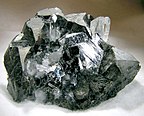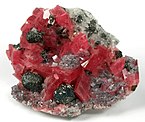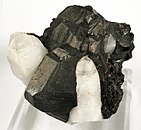Tetrahedrite
Tetrahedrite is a copper antimony sulfosalt mineral with formula: (Cu,Fe)
12Sb
4S
13. It is the antimony endmember of the continuous solid solution series with arsenic-bearing tennantite. Pure endmembers of the series are seldom if ever seen in nature. Of the two, the antimony rich phase is more common. Other elements also substitute in the structure, most notably iron and zinc, along with less common silver, mercury and lead. Bismuth also substitutes for the antimony site and bismuthian tetrahedrite or annivite is a recognized variety. The related, silver dominant, mineral species freibergite, although rare, is notable in that it can contain up to 18% silver.
Mineralogy
Tetrahedrite gets its name from the distinctive tetrahedron shaped cubic crystals. The mineral usually occurs in massive form, it is a steel gray to black metallic mineral with Mohs hardness of 3.5 to 4 and specific gravity of 4.6 to 5.2.
Tetrahedrite occurs in low to moderate temperature hydrothermal veins and in some contact metamorphic deposits. It is a minor ore of copper and associated metals. It was first described in 1845 for occurrences in Freiberg, Saxony, Germany. Historically, it was an important ore of copper, the formula Cu3SbS3 corresponding with 57.5% of the metal; it was also worked as an ore of silver, of which element it sometimes contains as much as 30%.[3]
Applications
The now-defunct company Alphabet Energy announced plans to offer a thermoelectric device based on tetrahedrite to turn heat into electricity. The company claimed that other thermoelectrics typically produce about 2.5 percent efficiency, while tetrahedrite could achieve 5 to 10 percent.[4]
Other thermoelectrics are either scarce, expensive ($24–146/kg vs $4 for tetrahedrite) and/or toxic. Working with a natural material also reduces manufacturing costs.[4]
Images
-
 Tetrahedrite crystals with chalcopyrite and sphalerite from the Casapalca Mine, Peru (size: 8.2 × 6.4 × 4.7 cm)
Tetrahedrite crystals with chalcopyrite and sphalerite from the Casapalca Mine, Peru (size: 8.2 × 6.4 × 4.7 cm) -
 Tetrahedrite from Casapalca Mine, Casapalca, Huarochiri Province, Lima Department, Peru
Tetrahedrite from Casapalca Mine, Casapalca, Huarochiri Province, Lima Department, Peru -
 Rhodochrosite with fluorite, tetrahedrite and quartz; the tetrahedrite occurs as sharp, metallic crystals
Rhodochrosite with fluorite, tetrahedrite and quartz; the tetrahedrite occurs as sharp, metallic crystals -
 Tetrahedrite crystals to several inches on size in combination with quartz crystals
Tetrahedrite crystals to several inches on size in combination with quartz crystals
See also
References
- ^ Handbook of Mineralogy
- ^ "Tetrahedrite: Tetrahedrite mineral information and data". Mindat.org. 2014-07-12. Retrieved 2014-07-17.
- ^
 One or more of the preceding sentences incorporates text from a publication now in the public domain: Spencer, Leonard James (1911). "Tetrahedrite". In Chisholm, Hugh (ed.). Encyclopædia Britannica. Vol. 26 (11th ed.). Cambridge University Press. pp. 670–671.
One or more of the preceding sentences incorporates text from a publication now in the public domain: Spencer, Leonard James (1911). "Tetrahedrite". In Chisholm, Hugh (ed.). Encyclopædia Britannica. Vol. 26 (11th ed.). Cambridge University Press. pp. 670–671. - ^ a b Jacobs, Suzanne (2014-07-12). "Cheaper Thermoelectric Materials | MIT Technology Review". Technologyreview.com. Archived from the original on 2014-07-17. Retrieved 2014-07-17.
External links
 Media related to Tetrahedrite at Wikimedia Commons
Media related to Tetrahedrite at Wikimedia Commons- Hurlbut, Cornelius S.; Klein, Cornelis, 1985, Manual of Mineralogy, 20th ed., Wiley, ISBN 0-471-80580-7
- Mineral galleries
- Webmineral data
















